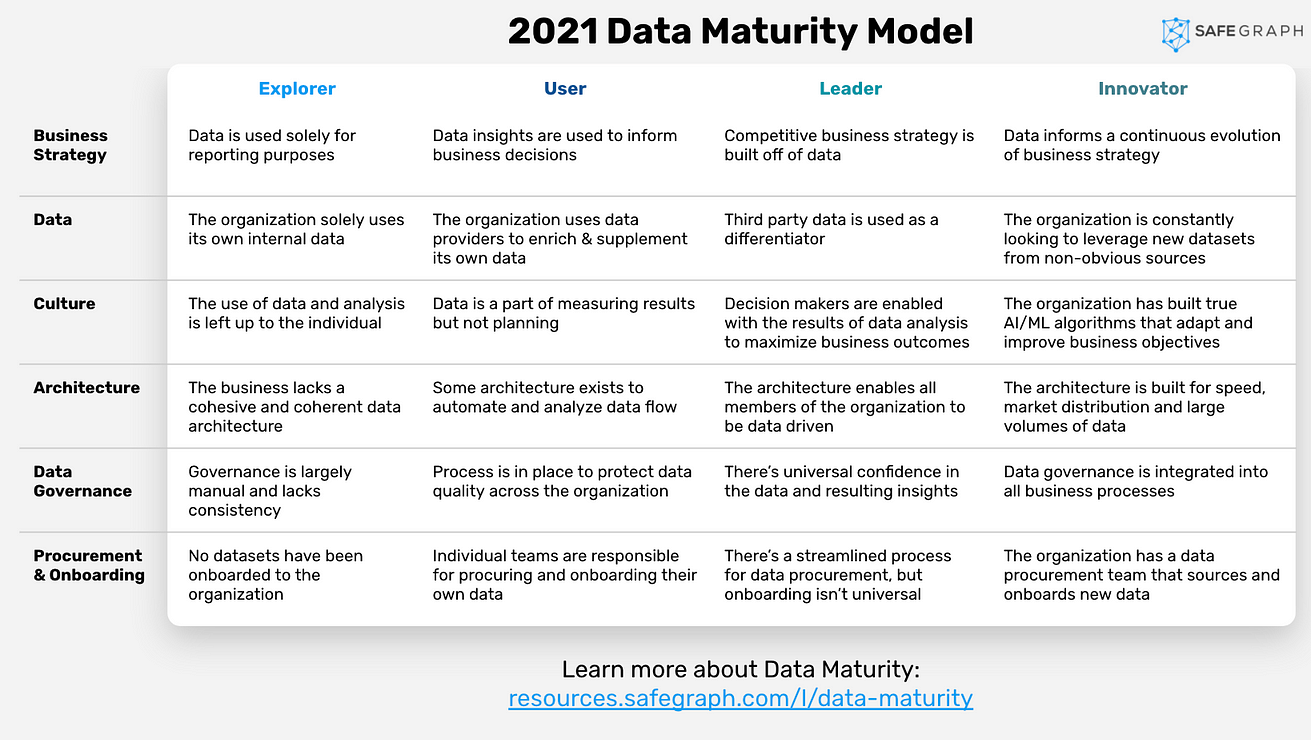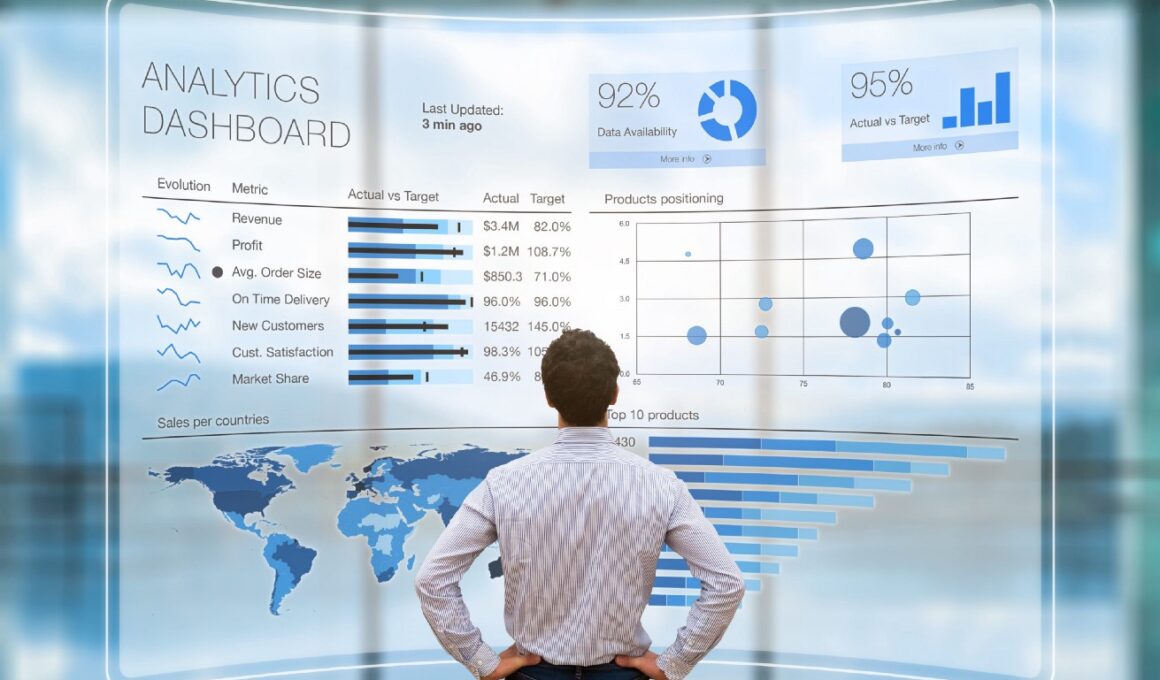Safegraph
by Korri Palmer
January 20, 2021
Site editor:
Joaquim Cardoso MSc.
Transform Research — research institute for digital and health
Data Driven Health Care Unit
August 28, 2022
Data maturity is dependent on data governance, data management, data literacy, and other data analytics capabilities.
If you’re reading this, you probably know a thing or two about data.
Data is one of the most rapidly growing resources in our world, with an estimated 2.5 quintillion bytes created every day.
It seems like data is everywhere, but in reality, we’re just getting started with it.
Over 90% of data existing today was created within the last five years.
But something changed in the last year that made us want to reconsider what data maturity means today: data usage.
Businesses using data to guide decision making has skyrocketed in the last year.
The pandemic forced businesses to redefine baselines, find new customers, and make hard decisions about where to close operations.
These tough decisions forged more data mature businesses.
While innovative businesses have gotten more mature, there are still many organizations that are just beginning their data journey.
This model speaks to all stages of the data maturity journey.
Businesses using data to guide decision making has skyrocketed in the last year.
While innovative businesses have gotten more mature, there are still many organizations that are just beginning their data journey.

What is Data Maturity?
Data maturity is a measurement of the extent to which an organization is utilizing their data.
To achieve a high level of data maturity, data must be deeply ingrained in the organization, and be fully incorporated into all decision making and practices.
Data maturity is often measured in stages.
Sisense tells us that “data maturity is a measurement of how advanced a company’s data analysis is.” Seems like a reasonable definition, but what does that really mean?
Data maturity is not just about the role that data plays within an organization’s day-to-day operations as much as it is about how it can enable organizations, of all shapes and sizes, to do something in the future that it couldn’t have done in the past without using data.
When looking at data maturity from this angle, it becomes a question of empowerment: how can data be leveraged in a powerful way to unlock new insights and innovations that can eventually turn ideas into reality?
Data maturity is a journey of exploration-where organizations not only get more acquainted with the data sources they have to work with but also learn how to leverage it in oftentimes surprising, eye-opening, and unexpected ways.
In fact, once organizations take the big step from seeing data as merely a source of information and, over time, begin to understand its real potential as an influencer-or even disruptor-of decision-making, an organization’s desire to become more data mature will likely (and immediately) increase tenfold.

Data Maturity Model: Defining the Varying Levels of Experience Companies Have With Data
To better understand these differences, we researched and developed a data maturity model that details the different levels of experience companies have with data and how that experience manifests in different areas of the business.

Our data maturity model isn’t wildly revolutionary. Others came before and helped guide us in the right direction. But we hope this sheds light on data maturity in 2021, and gives companies direction as they start to become more data mature.
Most data mature businesses are way more advanced than before, and this plays out across the categories of data maturity.
- They’re working with a wide variety of data, whether they be structured or unstructured datasets,
- they’re searching out companies that might have exhaust data to help them further differentiate their business, and
- they’ve built their infrastructure to handle all this data and to uncover insights fast, very fast.
We added a new category for data maturity — procurement and onboarding, it’s not flashy, but the process is required for speed and scale.
The companies that are the most data mature have a team dedicated to procuring and onboarding new datasets so that the data can be leveraged anywhere in the business that decisions are made.

The 4 Stages of Data Maturity: Where Does Your Organization Fall?
Many companies and industries have developed data maturity curves or models to illustrate how data can be integrated into business processes.
Data maturity curves and models exist for very specific topics, such as customer data, as well as more universal themes like data governance.
The SafeGraph data maturity model is designed to be generally applicable across all organizations, regardless of the specific type of data they use.
To create our data maturity model, we looked at six aspects of a business:
- strategy,
- data,
- culture,
- architecture,
- data governance, and
- procurement/onboarding.
We used the different levels of sophistication across each of these aspects to then develop four unique stages in data maturity.

The Four Stages of Data Maturity
Stage 1. Explorer
- Organizations that are just getting started with data generally do not have a defined strategy for incorporating data into their business.
- While they may use data for reporting purposes, it is on an ad-hoc basis.
- They do not source data for these reports and only use internally-collected data.
Stage 2. User
- User organizations are aware of how important data quality is for success.
- They make it a standard to use data internally across the organization with the addition of ad-hoc datasets to assist with amplifying internal data sources.
- Their reactive use of data is convenient for making insightful business decisions.
Stage 3. Leader
- Similar to Users, Leaders centrally use data for decision making within their organization.
- However, they also use data for competitive intelligence. In order to accomplish organizational missions and business success, Leaders use third party datasets in addition to their own data.
Stage 4. Innovator
- Data is used for more than just analysis and observation. In fact, organizations that are Innovators are using data to create algorithms and predict how they can stay ahead of the game.
- With data governance being a part of the entire organizational business strategy, Innovators must constantly utilize data in new ways to adapt to the uncertainty of the future.

Top 3 Data Maturity Assessment Questionnaires to Benchmark Your Organization’s Experience Level
Most organizations today are using data in some capacity, but those that have reached the Innovator stage, where data is at the center of their strategy and operations, are truly leveraging it to the fullest potential.
Most organizations today are using data in some capacity, but those that have reached the Innovator stage, where data is at the center of their strategy and operations, are truly leveraging it to the fullest potential.
How data mature is your organization?
Here’s a round-up of self-assessment tools you can take to find out, and contribute to industry research on the topic.
We developed a survey aimed at establishing industry benchmarks of data maturity. By taking our survey, you’ll reflect on your own organization’s use of data and help us dive deeper into our research. Results are anonymous and will be shared in a white paper and webinar in the coming months.
TDWI developed this assessment to help determine the maturity of your organization’s big data initiatives in an objective way when compared with other companies.
You can complete the assessment and receive a set of scores indicating your big data maturity across five dimensions that are key to deriving value from big data analytics: organization, infrastructure, data management, analytics, and governance.
The Center for Data Science and Public Policy at the University of Chicago created a data maturity framework for non-profits and government organizations based on organizational, data, and technology readiness.
Their matrix and assessment questionnaire are designed to help benchmark non-profit and government organizations’ ability to start data-driven social impact projects.

Data Maturity is Continuously Evolving
Data is one of the most valuable assets available to any organization today. Unfortunately, many simply don’t know how to use data to its fullest.
So if your organization falls into this category, don’t worry-it just means that you are on the start of your own data maturity journey.
And as the amount of data available continues to grow and become more accessible, the ways in which organizations can use data — and be data mature — will continue to evolve.
The good news for you: There are a lot of ways to become a data mature business.
It’s not always a linear path nor is it going to happen over night.
But when you make the important decision to put data at the heart of your organization-to fuel business strategy, inform decision-making, and uncover competitive intelligence like never before-you are taking the first step in bringing your organization into the data age.
Originally published at https://www.safegraph.com.











